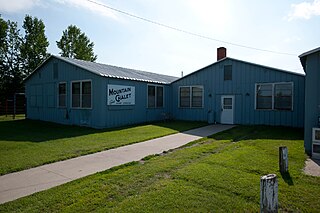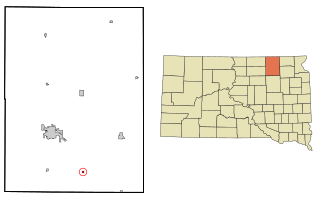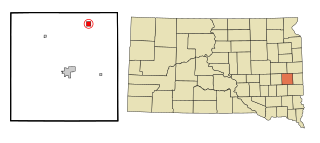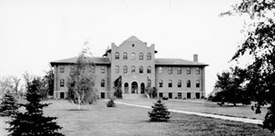
St. Vincent is a hamlet in Kittson County, Minnesota, United States. The population was 57 at the 2020 census.

Portal is a city in Burke County, North Dakota, United States. The population was 125 at the 2020 census. Portal was founded in 1893.

Canton City, also known as Hensel, is a city located on the east edge of Park Township in Pembina County, North Dakota, United States. The population was 31 at the 2020 census.

Cavalier is the largest city in Pembina County, North Dakota, United States. It is the county seat of Pembina County. The population was 1,246 at the 2020 census. Cavalier was founded in 1875 and became the county seat in 1911.

Crystal is a city in Pembina County, North Dakota, United States. The population was 116 at the 2020 census. Crystal was founded in 1879.

Drayton is a city in Pembina County, North Dakota, United States. The population was 757 at the 2020 census. Drayton was founded in 1878.

Hamilton is a city in Pembina County, North Dakota, United States. The population was 46 at the 2020 census.

Mountain is a city in Thingvalla Township, Pembina County, North Dakota, United States. The population was 80 at the 2020 census. Mountain was founded in 1884.

Neche is a city in Pembina County, North Dakota, United States. It sits on the banks of the Pembina River. The population was 344 at the 2020 census.

Walhalla is a city in Pembina County, North Dakota, United States. It sits on the banks of the Pembina River, five miles from the border with Manitoba (Canada) and approximately 45 mi (72 km) from the border with Minnesota. The population was 893 at the 2020 census.

Dunseith is a city in Rolette County, North Dakota, United States. The population was 632 at the 2020 census. Dunseith is best known for its proximity to the International Peace Garden. The port of entry at the Peace Garden is one of three 24-hour ports in North Dakota. Dunseith is also the home of the world's largest turtle sculpture, the "W'eel Turtle", made of more than 2,000 wheels painted green.

Stratford is a town in southern Brown County, South Dakota, United States. The population was 57 at the 2020 census.

Morristown is a town in Corson County, South Dakota, United States. The population was 67 at the 2010 census.

Nunda is a village in Lake County, South Dakota, United States. The population was 46 at the 2020 census. Located there are a post office, grainery, bar and grill, and an American Legion post.

Eden is a town in Marshall County, South Dakota, United States. The population was 94 at the 2020 census.

Lake City is a town in Marshall County, South Dakota, United States. The population was 45 at the 2020 census. Fort Sisseton Historic State Park, whose fort is listed on the National Register of Historic Places, is located nearby.

Long Lake is a town in McPherson County, South Dakota, United States. The population was 27 at the 2020 census.

Ortley is a town in Roberts County, South Dakota, United States. The population was 50 according to the 2020 census.

Batesland is a town in Oglala Lakota County, South Dakota, United States. The population was 100 at the 2020 census.

Glenham is a town in Walworth County, South Dakota, United States. The population was 112 at the 2020 census.






















